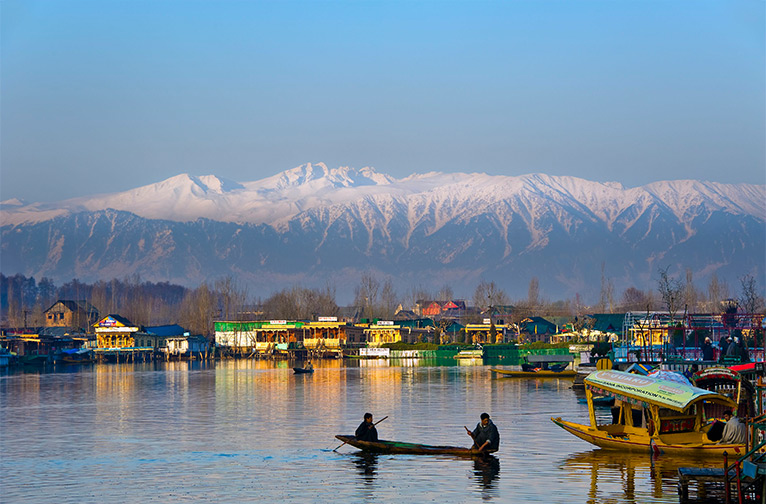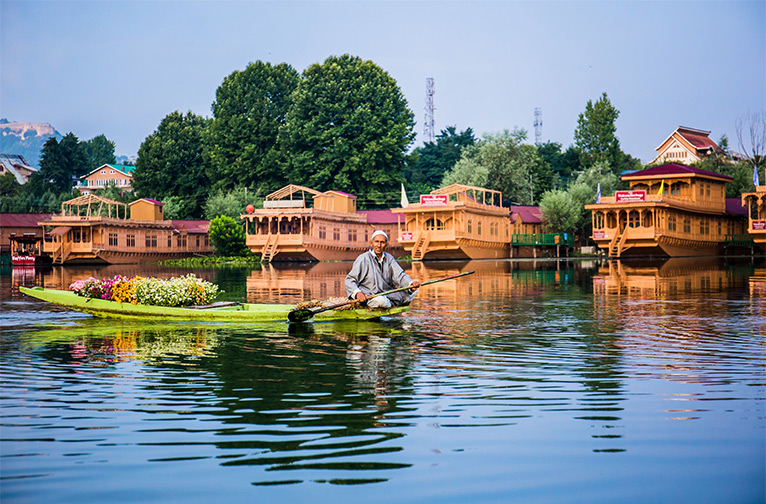With its heavenly snow peaks, mystical caves, alpine meadows, rich pastures, crystalline streams, azure lakes, forests, saffron fields, stands of Chinar trees, flower gardens, orchards of apples, cherries and walnuts and almonds the Kashmir Valley is a bewitching holiday destination all year round and easily accessible from the ancient city of Srinagar, summer capital of the state of Jammu & Kashmir.
Way back in time, during the Pleistocene epoch, the area we know today as the legendary Kashmir Valley was actually one massive lake–the Karewa Lake. A massive tectonic shift in the region where it was between the main range of the Himalayas on the northeast and the Pir Panjal Range on the southwest resulted in draining Karewa Lake. What was left in the wake of this humongous geological upheaval was this ‘emerald set in pearls’–a vast vale of surreal beauty, heightened further by the snow-capped peaks rising to a sheer height of between 3,600 to 4,800 metres. The Valley’s mystique as a ‘Paradise on Earth’, voiced so eloquently by the 13th century Indo-Persian Sufi poet Amir Khusrau, disciple of Sufi Saint Nizamuddin Auliya, is a potent allurement for the traveller even today.
PLEASURE GARDENS
Shalimar Bagh
During one of his three visits to Kashmir the Mughal Emperor Akbar around 1586 commissioned the Naseem Bagh (Garden of Pleasant Breezes). But it was his son Jehangir who summered in Kashmir 14 times, who embellished the city of Srinagar with that fabulous garden in the Persian mould–the Shalimar Garden.
For the Mughal Emperor Jehangir, an avid botanical buff and for whom ‘Kashmir was worth all of Hindustan’, created the splendorous Shalimar Gardens. Here he and his beloved empress, Nur Jehan, would navigate the stepping stones across the gurgling brook to spend hours exploring its superb plethora of tree-lined trellised walkways, pavilions, pools, cascades, fountains flowerbeds, rose bushes, spreading Chinar trees, lilac trees, and cherry trees. Inscribed on the black pavilion on the top terrace are the immortal words of poet Amir Khusrau:
‘Agar Firdaus bar roo-e-zameen ast
Hameen ast-o hameen ast-o hameen ast’
or, ‘If there’s Paradise on Earth, it is this, it is this, it is this…’
Originally called Bagh-i-Farah Bakhsh (‘joy imparting’) by Jehangir, the garden, built in 1619, is linked through a channel to the northeast of Srinagar’s iconic Dal Lake. The three-tiered setting is adapted to the beautiful lines of a Persian garden with a central water channel, Shah Nahar, feeding the three terraces. In 1630, it was further extended with the direction of Jehangir’s son Emperor Shah Jahan, who named it ‘Faiz Baksh’ (‘the bountiful’). Be here in the spring and in the autumn for sure to see the splendour of the Chinars in their sunset hues.
Chashma Shahi
Shah Jehan also was behind the development of the terraced Chashma Shahi or Spring Royal Garden. In 1632 the garden was built around a bounteous spring emerging from the Zabarwan Mountains. From its high terraces you get magnificent views and the cool spring water too is of great significance still. A 5-minute drive brings you to Pari Mahal, famed for the ruins of the royal observatory in a pretty garden on the spur of a mountain overlooking the Dal Lake. Asia’s first residential Sufi school was set up here by Shah Jehan’s son Prince Dara Shikhoh.
Nishat Garden
This terraced Mughal garden also nestles along the eastern shoreline of the Dal. Nishat Bagh is a picturesque leisure space with the backdrop of the verdant Zabarwan Mountains. Empress Nur Jehan’s brother, Asif Khan, was the brainchild behind this lovely spot. When his brother-in-law Khan refused to take the hint that it should be gifted to him, the emperor, in a fit of pique, had the water supply to the garden cut off! Comprising two sections, the public gardens and the private one for the zenana, it had 12 terraces representing the Zodiacal signs. Nishat Bagh is one of the finest representations of traditional char bagh garden layouts spread across the Islamic world.
Tulip Garden
Springtime is resplendent with Kashmir’s legendary natural beauty. Slip into the Indira Gandhi Memorial Tulip Garden during the annual festival in spring and spend hours soaking in the fabulous kaleidoscope of colours that greet the eye at every turn. Amongst the rare species here is the “Queen of the Night”. Be here for the blooms from March to May.
TRANQUIL WATER WORLDS
Dal Lake


The enchantments of Srinagar’s icon lake have long passed into the legend. While Hindi cinema of 60s bought out the most romantic aspects of shikara rides on the Dal, there are many more interesting aspects to the glorious water body which is the centrepiece of tourist activity in the city along the boulevard stretching from Dal Gate to Nehru Park. The lake, with its lively rural hinterland world connected by a network of water channels, is also an important resource for commerce and livelihood for the families, farmers and fisherfolk through fishing and water plant harvesting boat rides for the tourist crowds. Be there in July and August to witness the blooming lotuses on the ‘floating gardens’ (raad). An unmissable experience is a crack of dawn visit to the floating vegetable market. Do stay a night at least at one of the luxury houseboats moored along the shore. Don’t miss the floating post office, floating mosque and floating market or lake market where you can shop for saffron and local handicrafts.
Nigeen Lake
‘The Jewel in the Ring’, Nigeen is so called because of its wraparound line-up of willow and poplar trees. Less noisome than Dal, it’s the perfect retreat for visitors looking for a more reflective experience. Water sports activities also operate across from the Nigeen Club.
Wular Lake
A beautiful 60 km drive from Srinagar brings you to Wular a tranquil spot with a rural ambience. The viewpoint near Watlab in Sopor offers spectacular views of the lake and its reflection of Mt. Harmukh. The lake is fed by the Jhelum from the south-east and fattened further by the waters of small streams such as Harbuji, Aarah, Erin and Pohru. Storms come up on the lake in the afternoons. The island, ‘Zaina Lank’, at the centre of the lake was built by Sultan Zainul-Abi-Din. Wular, which is a great resource for fish and water chestnuts which drive the economy of the area, is also an important wetland and avifaunal migratory destination; it’s a paradise for birders.
Words on the Valley’s incomparable beauty from Emperor Jehangir’s memoir Tuzk-i-Jehangiri will always resonate with those of us who want to return here again and again: “Kashmir is a garden of eternal spring, or an iron fort to a palace of kings — a delightful flower-bed, and heart-expanding heritage for dervishes. Its pleasant meads and enchanting cascades are beyond count.”